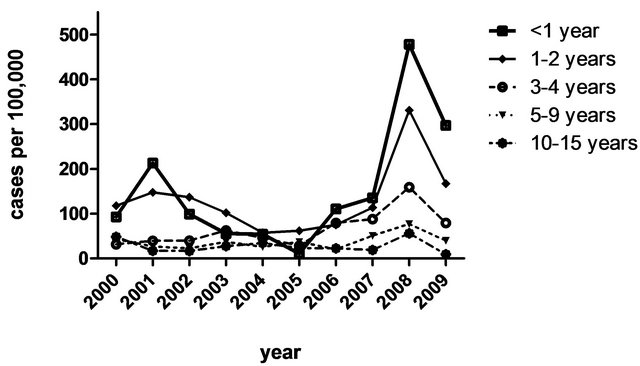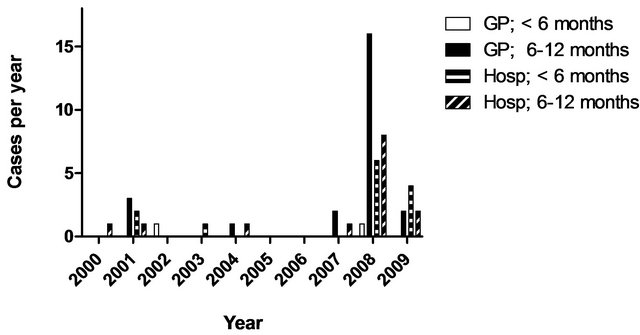Open Journal of Pediatrics
Vol.3 No.1(2013), Article ID:28626,4 pages DOI:10.4236/ojped.2013.31005
National outbreak of Salmonella typhimurium with preference for infants*
![]()
1Department of Pediatrics, Copenhagen University Hospital, Hvidovre, Denmark
2Department of Clinical Microbiology, Copenhagen University Hospital, Hvidovre, Denmark
Email: #lottejensen@dadlnet.dk
Received 7 September 2012; revised 27 November 2012; accepted 6 December 2012
Keywords: Salmonella typhimurium; Non-Typhoidal Salmonella; Gastroenteritis; Infants; Children
ABSTRACT
Purpose: During a large outbreak of Salmonella typhimurium (S. typhimurium) in Denmark in 2008, a remarkable high incidence was observed among children below the age of 1 year. Therefore we performed this retrospective study to describe the epidemiology, severity and outcome among a subset of children in this age-group. Methods: Cases were identified for the years 2000-2009 through a register at the Department of Clinical Microbiology at Hvidovre Hospital, in the Copenhagen area, Denmark. For hospitalized patients below 1 year with S. typhimurium, the medical record was reviewed. Results: The highest incidence for S. typhimurium was observed in 2008 with 315 cases per 100,000 among children below 1 year. In 2008 significantly more children age <6 months were admitted to the hospital compared to infants 6 - 12 months. The duration of symptoms before admittance was shorter among the infants in 2008, compared to the group consisting of infants in other years 2000- 2009 (p = 0.04). None of the children had bacteremia or meningitis, and none of the children died. Conclusion: During the S. typhimurium outbreak in 2008, the incidence was especially high among infants age under 1 year. The infants in 2008 might have been slightly more affected than other years 2000-2009.
1. INTRODUCTION
Infections with non-typhoidal Salmonella species are common causes of gastroenteritis [1] and individuals at the extremes of age, or immune-compromised, are most susceptible to the infection [2].
A large outbreak of S. typhimurium U292 took place in Denmark in 2008, presumed to be originated from pork-meat, although no definitive source was identified [3]. A remarkable high number of cases among children below the age of 1 year were observed [4,5], and made us perform this retrospective study with the intention to describe the epidemiology, severity and outcome of non-typhoidal Salmonella infections in infants below 12 months of age in the Copenhagen area.
2. MATERIALS AND METHODS
This study focuses on infants (children aged 0 - 12 months) S. typhimurium infection, in the years 2000- 2009 in the Copenhagen area, Denmark. In order to put this into perspective, all cases of non-typhoidal Salmonella infections in children 0 - 15 years are summarized.
Case definition: All patients from whom a clinical sample (from blood, stool or urine) have identified nontyphoidal Salmonella spp. in the 10-year period from 2000-2009.
Study population: The Copenhagen area, Denmark, includes three municipalities, Copenhagen, Frederiksberg and Bornholm (from 2005); with on average 9277 infants (in average 94,572 children ≤15 years of age, in average 630,000 inhabitants). There are five public hospitals; Amager, Bispebjerg, Bornholm, Frederiksberg, and Hvidovre Hospital, a number of small private hospitals, and one tertiary hospital, Rigshospitalet. All patient samples from the study area are routinely examined at a single hospital-based clinical microbiology department (The Department of Clinical Microbiology, Hvidovre Hospital), with the exception of samples collected from patients admitted to the tertiary referral hospital. All isolates were referred to Statens Serum Institut, Copenhagen for typing.
All Danish residents have a unique 10-digit personal identification number (incorporating age and gender), which makes all patient sample identification possible. Population data for the years investigated was obtained from Statistics Denmark [6].
Study protocol: Cases were identified by retrospective review of clinical microbiology department data for the study period 2000-2009.
For hospitalized cases below the age of 1 year a medical record review was undertaken. Information on duration of symptoms before admission, length of stay, diagnosis, treatment and outcome were collected for analysis.
Statistical analysis: Fishers exact test was used for categorical variables.
3. RESULTS
In total 627 cases of non-typhoidal Salmonella infection in children ≤15 years of age, were identified in the years 2000-2009. Among these 23% (147 cases) were infants (age <12 months). The incidence of all non-typhoidal Salmonella infections is shown in Figure 1 (range 10 - 477 cases per 100,000), and illustrates the fluctuations in incidence rates over the years in the different age groups. The highest incidence was seen in children in 2008, and was especially high among the infants (age <12 months) with 477 cases per 100,000.
The proportion of S. typhimurium cases in infants among all cases in children (age ≤15) were in the years 2001 and 2008 especially high, 33% and 31%, respectively (Table 1). The proportion of cases in infants among all annual cases, were in 2001 and 2008, 17% and 16%, respectively.
The incidence of S. typhimurium among infants was up to 3.9 times higher in 2008 than in any other year 2000-2009 with 315 cases per 100,000.
Figure 2 shows the number and age of infants with S. typhimurium infection admitted to hospital or managed in general practice. During the S. typhimurium outbreak in 2008, 86% (6 of 7 cases) of the infants age <6 months were admitted to the hospital compared to 33% (8 of 24 cases) among the infants age 6 - 12 months (p = 0.03).
In total 27 infants had a positive sample showing S. typhimuriun in the years 2000-2009. Three patients (from 2000, 2001 and 2009) were excluded from further analysis because their medical records were missing. From the 24 patient records, data regarding duration of symptoms before admission, length of hospital stay, treatment and outcome were extracted. Only 1 patient

Figure 1. All non-typhoidal Salmonella infections in children in the Copenhagen area, Denmark, 2000-2009.

Figure 2. Number of S. typhimurium infections diagnosed from samples taken at hospitals or GP’s, in children below 6 months and children 6 - 12 months of age.
Table 1. S. typhimurium infections among infants compared to all children (age 0 - 15) and all cases.

from 2009 had a history of travelling abroad.
The duration of symptoms before admittance among the infants in the “2008” group, compared to the “2000- 2007 and 2009” group, was shorter, and more children had been ill 3 days or less (p = 0.04). In 21% (3 of 14) of the infants in the “2008” group, intravenous therapy was administered shortly after admission, compared to none in the “2000-2007 and 2009” group (p = 0.24).
The fraction of patients given antimicrobial treatments (approximately one third), and the length of hospital stay were similar in the two groups (data not shown). None of the patients had documented bacteremia or meningitis, and none of the children died.
4. DISCUSSION
During the S. typhimurium U292 outbreak in 2008 the incidence rate for infants in the Copenhagen region was high, with 315 cases per 100,000 compared to a mean incidence of 26 cases per 100,000 over the remainder of the study period. In our area we found 7 infants <6 months and 24 infants 6 - 12 months of age. The outbreak was presumed to originate from pork [3], a kind of food which infants <6 months are not presumed to be eating.
Whether this S. typhimurium was very infectious and transmitted from parents/caretakers to the infant, or there were other sources than pork meat, is uncertain. Powdered infant formula has been found to cause outbreaks of Salmonella infection in infants [7] but in our review of medical records it was not possible to identify specific foods that may have explained illness in children below 6 months of age in 2008.
In 2008, 86% of the infants <6 months were admitted to the hospital compared to 33% among the infants 6 - 12 months (p = 0.03). This could be because the youngest were more severely affected or because of increased awareness of fever and possible signs of dehydration among the youngest. Generally the children in the “2008” group had a shorter duration of symptoms before admittance than the “2000-2007 and 2009” group (p = 0.04). The presence of symptoms with fever, diarrhea and vomiting did not differ significantly among the groups.
Only one child in the “2008” group was moderately dehydrated, and none was judged to be severely dehydrated. Three children in the “2008” group needed intravenous fluid compared to none in the “2000-2007 and 2009” group.
These infections in infants would all seem to have been locally acquired within Denmark with only a single child infant case in 2009 reporting a history of travel. None of the infants in our study developed invasive infections like bacteraemia, meningitis or septic arthritis which can be seen with non-typhoidal Salmonella infections, especially in the developing world [8,9], and none of the children died.
Recently, a similar finding of a Salmonella outbreak in USA from 2004 to 2011 which especially affected children, and were associated to live poultry delivered from a mail-order hatchery [10]. The authors focused on the possible wide spread of Salmonella from hatcheries and on the importance of hand hygiene, but did not, so far, explain this Salmonella enterica serotype Montevideo’s special affection for children [10].
In conclusion, a large outbreak of S. typhimurium U292 took place in Denmark during 2008. The source, al though never identified, was assumed to be pork. However, the incidence was especially high among infants 0 - 12 months, an age group with very little, if any, dietary intake of any meat. Interfamilial transmission in these young infants may be more likely. Our results indicate that the infants might have been more affected than other years 2000-2009 because of increased hospitalisation rate, shorter duration of symptoms before admission, and use of intravenous therapy.
REFERENCES
- Graham, S.M. Salmonellosis in children in developing and developed countries and populations. Current Opinion in Infectious Diseases, 2002, 15, 507-512. doi:10.1097/00001432-200210000-00009
- Hohmann, E.L. (2001) Nontyphoidal salmonellosis. Clinical Infectious Diseases, 32, 263-269. doi:10.1086/318457
- Ethelberg, S., Wingstrand, A., Jensen, T., et al. (2008) Large outbreaks of Salmonella typhimurium infection in Denmark in 2008. Eurosurveillance, 13, p. 19023.
- Ethelberg, S., Wingstrand, A., Jensen, T., et al. (2008) Large ongoing outbreak of infection with Salmonella typhimurium U292 in Denmark, February-July 2008. Eurosurveillance, 13, p. 18923.
- Ethelberg, S., Molbak, K., Olsen, K.E.P. and Scheutz, F. (2009) Zoonotiske tarminfektioner 2008. Statens Serum Institute.
- Statistics Denmark. http://www statistikbanken dk/statbank5a/default asp?w= 1280 2011
- Cahill, S.M., Wachsmuth, I.K., Costarrica, M.L. and Ben Embarek, P.K. (2008) Powdered infant formula as a source of Salmonella infection in infants. Clinical Infectious Diseases, 46, 268-273. doi:10.1086/524737
- Graham, S.M., Molyneux, E.M., Walsh, A.L., Cheesbrough, J.S., Molyneux, M.E. and Hart, C.A. (2000) Nontyphoidal Salmonella infections of children in tropical Africa. Pediatric Infectious Disease Journal, 19, 1189- 1196. doi:10.1097/00006454-200012000-00016
- Huang, I.F., Wagener, M.M., Hsieh, K.S., et al. (2004) Nontyphoid salmonellosis in Taiwan children: Clinical manifestations, outcome and antibiotic resistance. Journal of Pediatric Gastroenterology & Nutrition, 38, 518-523. doi:10.1097/00005176-200405000-00011
- Gaffga, N.H., Barton, B.C., Ettestad, P.J., et al. (2012) Outbreak of salmonellosis linked to live poultry from a mail-order hatchery. The New England Journal of Medicine, 366, 2065-2073. doi:10.1056/NEJMoa1111818
NOTES
*Conflict of interest: The authors declare that they have no conflict of interest.
#Corresponding author.

